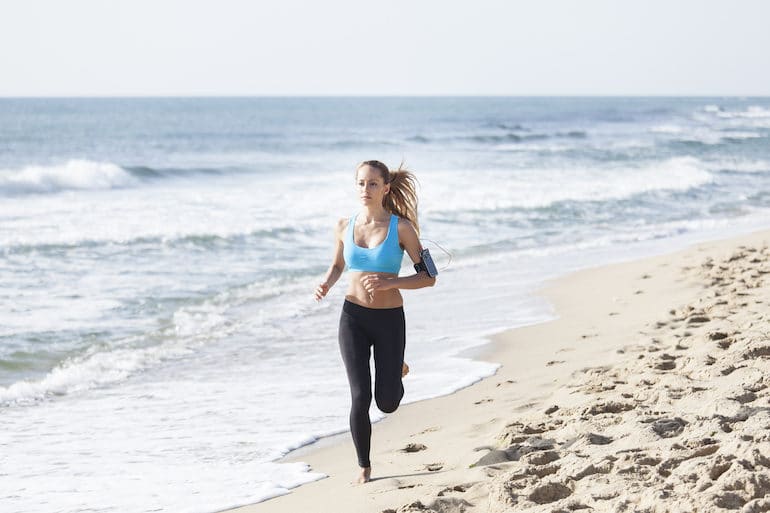Barefoot training—maybe you’ve heard of it. The workout technique has become a favorite among professional athletes and everyday fitness connoisseurs alike… but why? And should you jump on the bandwagon yourself?


The Basis of Barefoot Training
“Imagine chopping veggies or sewing a shirt, and the dexterity required to do so with our hands,” Gold’s Gym fitness expert Tory Hale, CPT says. “Now imagine trying to do the same thing with thick gloves on. Nearly impossible, right? That’s because our hands have thousands of nerve endings. Without good input, performing highly complex movements becomes difficult.” The same is true of our feet; wearing shoes prevents them from working to their full potential. “Going barefoot can help awaken the nerve endings. It gives us better input from the ground under us,” Tory explains.
How Sneakers Can Hinder Athletic Ability
Now don’t get us wrong—we love today’s sneaker market. Neon shades, chunky soles, and stretchy laces have made wearing casual kicks that much more fun. But unfortunately, despite their claims, they’re not always the best option for promoting physical wellness.Alignment
“Modern footwear typically uses both a soft and gel-like support, while also elevating the heel,” Tory notes. “Heel elevation causes shifts in weight distribution; it drives the knees forward. To counteract that, the butt then goes back further, and it continues up the spine through the head. One of the most important aspects of training is to reinforce proper alignment in the body. If the base we’re standing on compromises our entire alignment, then we already have a mechanical disadvantage to whichever exercise we’re performing.”Gravity
Tory continues, “Then there’s the body’s ability to create force and transfer that into an object like a kettlebell, dumbbell, or even your own weight in a squat. The amount of force we can produce is directly relational to the contact we have with the ground. Without gravity, we can’t produce force. If our contact point with the ground isn’t receiving good input because of highly cushioned shoes, our bodies are unable to produce the maximal amount of force. This makes our movements less efficient overall.”Mobility
Gold’s Gym fitness expert Jackie Vick, CPT adds that foot mobility and ankle flexibility are key factors in targeting the right muscle group and providing a safe and stable base to perform the movement. As such, wearing shoes can hinder this and potentially lead to rolled ankles and more severe full-body ailments. Simply put, sometimes it pays to sit back and kick your shoes off.Benefits of Barefoot Training
Believe it or not, barefoot training can enhance your overall physical health and well-being from head to toe. After all, why do you think so many boutique fitness classes call for barefoot (or grippy sock) participance? We’re looking at you, yoga, Pilates, and barre. “There are many benefits to barefoot training,” says Emily Splichal, DPM, Human Movement Specialist, and founder of Naboso Technology. “They include reconnecting to your body’s foundation (feet), improved glute and core strength, and better posture. The skin on the bottom of the feet has thousands of small nerves that tell the body when and how to engage the foot muscles. The more we stimulate our feet, the stronger they become,” and the greater these benefits will be. Tory adds that barefoot training also allows for greater muscle activation: “Proper alignment—paired with an increase in force production from better input from the ground—creates an environment where we can maximize strength and endurance.”
Is Barefoot Running Equally Effective?
The word training might make you imagine lifting weights in a gym or boutique studio setting, but there’s something to be said for barefoot running as well. “Occasionally running barefoot can strengthen the feet, leading to a more powerful stride,” says Rebekah Mayer, the national run program manager for Life Time Run. “Most runners naturally shorten their stride, increase their cadence, and land softly on their mid-foot when running barefoot. This can decrease the stress commonly transferred through the heel when heel-striking.” In that way, Jackie says that running barefoot can actually assist athletes and everyday fitness lovers to re-learn how to run in a more natural way. “I highly encourage all barefoot athletes to read Born to Run. It highlights the evolution of running in its most natural form, and displays the science of why minimalism came into modern shoe manufacturing,” she says.Are there Risks to Barefoot Training?
As with anything, there are potential downsides that pair with the benefits of barefoot training. “Like any type of training, too much too soon can always increase the risk of injury,” Splichal says. “Additionally, certain foot types (overpronation or oversupination) can be associated with a slight injury risk depending on the duration and intensity of barefoot training.” Next, jumping right into a barefoot routine may not only affect your feet, but also your knees, hips, and spine. “Whenever the heel of your foot strikes the ground under body weight or with a load, the impact is approximately three times your body weight,” Jackie says. “Repetitive strikes often lead to Achilles injuries and stress fractures in the shin bones.” Yikes!Final Thoughts
A gradual approach is essential to safe and effective barefoot training. “Start with short sections of your workout going barefoot. You may notice some aches in your Achilles, calves, and feet, but it’ll go away over time as the length of the tendon is restored,” Tory advises. The more you add these barefoot jaunts into your routine, the more comfortable you’ll get with the technique, and the more you’ll begin to notice its positive effects. Just keep in mind that after long barefoot runs and training sessions, your feet might need a little extra love on the texture and tension front. But hey, that just means you have an excuse to get a pedicure.More like this









